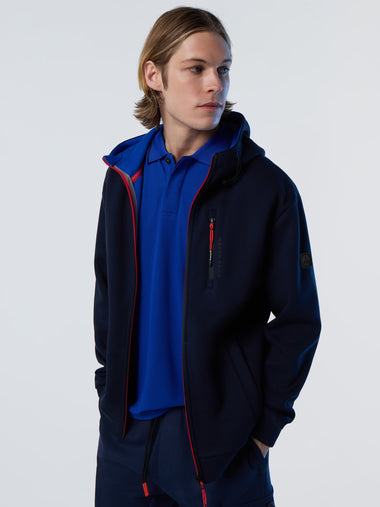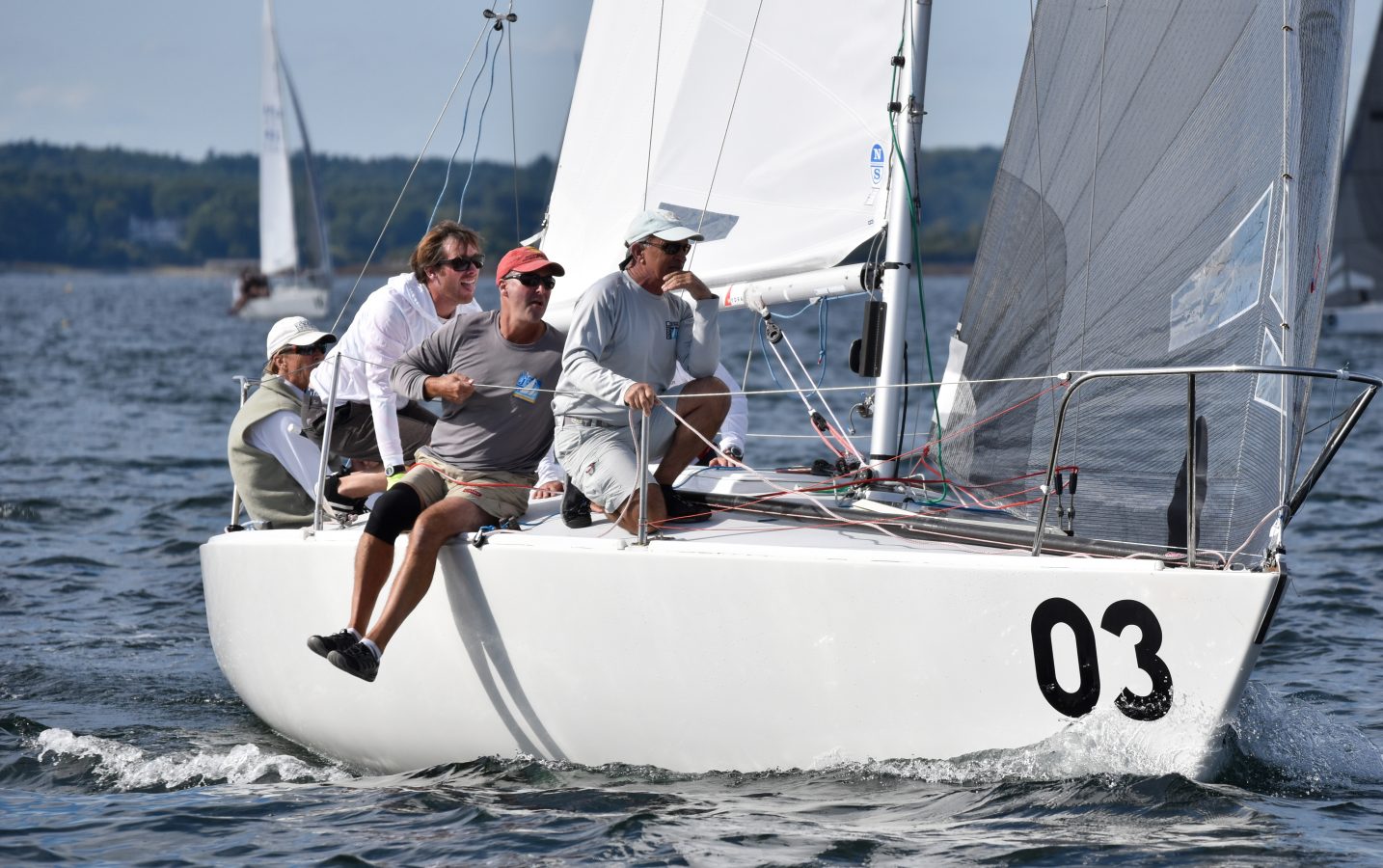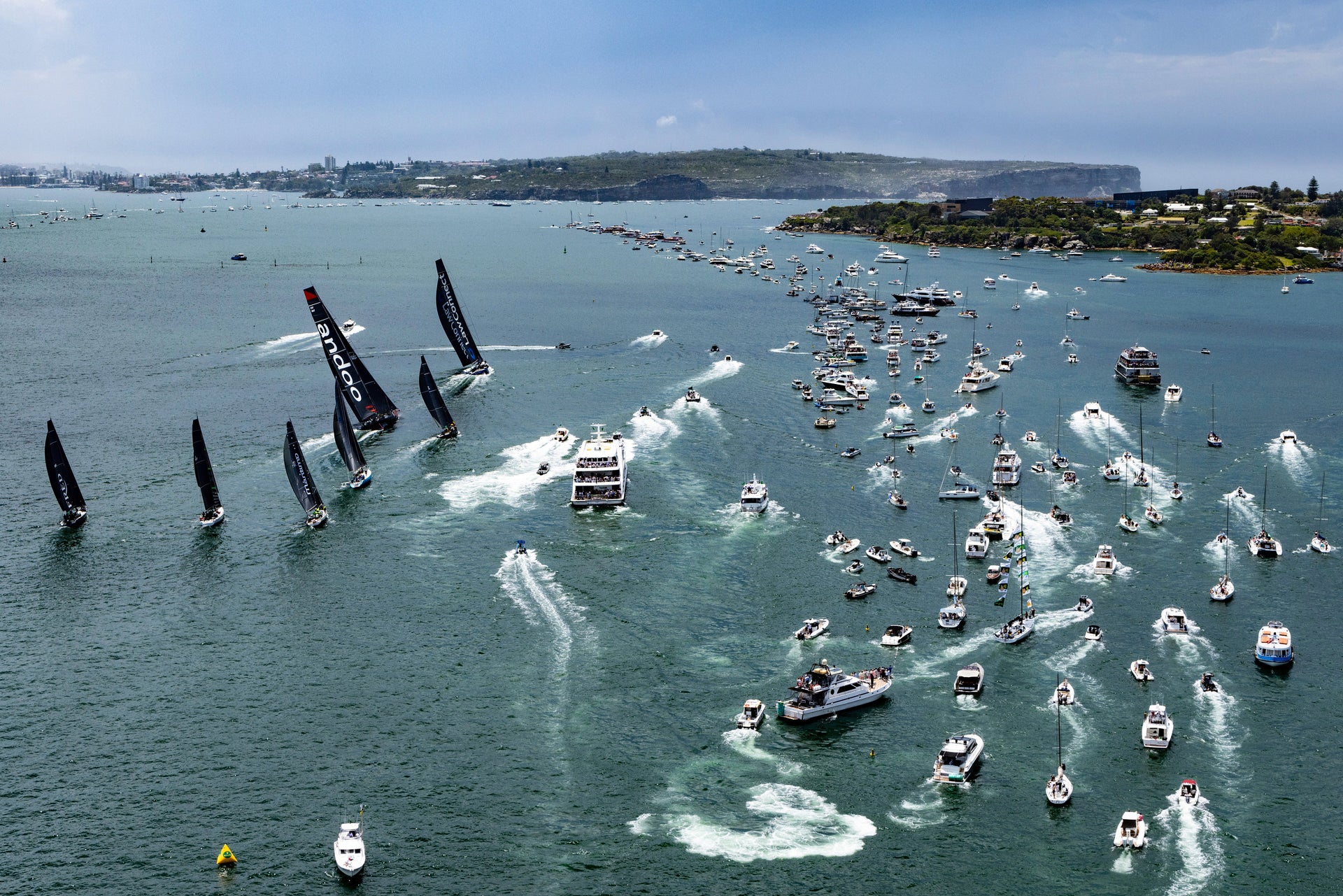J/24 NATIONALS: MANAGING STRONG CURRENTS & LIGHT AIR
J/24 NATIONALS: MANAGING STRONG CURRENTS & LIGHT AIR
Class Veteran Robby Brown Shares His Top Secrets

The 2018 J/24 US Nationals were hosted by the Portland Yacht Club in Casco Bay. We caught up with Robby Brown, skipper of the winning team Angel of Harlem for some insights:
You have been sailing J/24s for years on and off, can you tell us a little about yourself, how you got into the class and what keeps you coming back?
I have been in the J/24 class since the Mid 80’s. I began sailing J/24s regularly around 1995. While I sail in multiple classes, I love the competitive nature of the J/24 class and its relative affordability of keeping a World Class boat going. Over the years, the class has always offered top level competition, that’s the biggest reason that keeps me coming back. Combined with the great atmosphere of the competitors and the class, I have always enjoyed my time spent campaigning the J/24.
Who crewed for you at the Nationals and how long have you all been racing together?
We have been working hard to put together a World Class team in advance of the Worlds in Miami. We are sailing together more regularly with team consistency than we have ever been able to manage in the past.
Our team consists of a group of sailors whose lives have been connected for many, many years as sailors that enjoy sailing together. The biggest factor gluing the team together at this point is my partner Mark Liebel. Mark and I are full partners in our pursuit of a top finish at the 2019 Worlds. We began sailing together nearly 15 years ago when I first moved to the Tampa Bay area. Over the years, we have developed a great friendship and ability to work together based on trust and truly enjoying working together in pursuit of team goals.
Ron Hyatt has been my most steady contributor with his rock solid bow work. He and I have been regularly sailing together for 15 years as well. Ron is a huge contributor in every aspect of campaigning the boat. He will help with deliveries and is always working hard on the dock to insure that we are prepared for a championship outcome.
Arthur Blodgett has developed into a huge asset in the trimming position and has been able to find the time to join us on a fairly regular basis ever since he graduated from college sailing as an award winning sailor. He was my best sailor when I was the collegiate coach at Eckerd College. We have been working together for almost 10 years.
Brian Simpkins was our fifth for the Nationals. He was new to the team but nevertheless a key to team success. Brian and Mark have been sailing together for many years, and I can’t say enough good things about the job he did stepping right in and making a huge contribution to our team success. We are definitely hoping he will join us some more in the future as a regular part of the team.
There is a fair amount of current where the Nationals were sailed this year, how did you figure it out so quickly?
Mark and I have sailed at the venue in the past and Arthur is from the area. We knew enough to have great respect for the need to figure out the current. We are all experienced at figuring out new venues. I am a high school sailing coach who regularly faces new venues with my teams. Mark is active in many classes and is diligent in his contributions to insure we have a good plan for the venue we are sailing in. In the end, I feel we did more homework on a daily basis than the competition, being able to process this information to insure success.
Here’s what we did:
- We were determined to be the first boat off the dock, sailing the course area and examining trends and identifying course-specific opportunities to make gains.
- We were checking current all of the way to the course area first thing in the morning. All of the lobster traps were great current tell tails.
- We sailed both sides of the first beat in the morning to find the strong current. We examine where the water was rougher as an indicator of strong current.
- We played the ever changing current more than wind shifts.
- We made start strategies to get to the good current first and it paid.
What was your starting game plan against 50 other boats?
Hope and pray! This was true to some degree.
On the first two races we got caught up in crowds and were flushed at the start. Lesson learned, for the rest of the regatta we started toward the end that we liked, with a priority of staying away from the crowded areas. We would start just to one side or the other of the crowded area and still be as close as possible to where we wanted to be. With some good fortune, we had some great luck with starts in the last three races and were able to dig ourselves out and salvage the best possible finishes. Being able to escape the pack, and get out to the lead, we converted our good starts to 2-1-2 finishes, closing our gap to snag the victory.
We are constantly applying great focus to insuring we get good starts. The dynamics seem to be ever changing from event to event as far as getting off the line well. We feel that starts are the biggest benefactor of our ability to sail well at the Midwinters, North Americans, and finally the Nationals. Our big fleet start experience is definitely paying off.
You seem to have a pretty good light air gear, how did you set up your boat?
We definitely thought about this a great deal. We have been honing our speed for years and feel we have a particularly good gear in the light air. While we enjoy good boat speed in all conditions, the things we feel we do better than most in light air are a result of years of tuning, working with our North Team representatives, and living in an area where we get a lot of practice in light air. I noticed we did a couple of things differently than the most:
Primarily, we keep our mast butt well aft in the light air conditions.
This gives us the forestay sag that we utilize to really keep the boat powered up in light air. We never go below 20/15 on the rig. Rather, we push the mast butt back to get a really full genoa shape. This requires lots of scallops in the luff, as well as putting on backstay a little at times to pull some of the sag if the breeze gets bigger puffs or just picks up a little. We feel we are better pulling a little backstay on than we are if the rig was softer than 20/15. We felt like the puffs were a little too much for our tune. This has proven very successful for us
Secondly, we are weight farther forward and down in the boat more than anyone else.
Going downwind our spinnaker trimmer is one or two steps up on the cabin house, our tactician is standing on the cabin sole all the way forward in the hatch. Additionally our bow person and mast person go below and the mast person shifts from port to starboard side to balance the boat right up against the bulkhead and the bow person is in front of the bulkhead. I truly feel this was our secret to really superior downwind speed. We also had our fifth below upwind when it was very light. If he’s not hiking on deck, he is below against the bulkhead,
What sail designs do you use and why?
All of the North products are superior. Our choice for more years than I can count are Newport Upwind (Fat Head Mainsail, DX-7TT Genoa) and San Diego downwind (FR-2 Spinnaker). Rather than switching around between designs, we feel we have been able to get tremendous performance from these sails by sticking with the designs and honing our tuning of these sails over these many years.
Others have had great success with the many good product offerings available from North. We have been tempted to try something different a few times over the years, but we are always rewarded by our “if it ain’t broke don’t fix it” mentality. This has allowed us to develop our tuning model to a better than most performance through consistency.
What’s next on your sailing schedule?
We have a couple of great regattas on our schedule to close out the year here in Florida. We are preparing for the Southeast Regionals and Districts which will surely bring the best competition to the starting line. From there, we are working toward our best performance at Midwinters at our home Yacht Club, Davis Island.
We are planning to sail the St Pete NOODs as a tune up for the Midwinters and are hoping to coordinate tuning opportunities in addition to sailing as many of the major championships next year as possible. We hope to find good regattas in addition to the Nationals in Rochester, maybe some more NOOD regattas or the Newport Regatta. Please reach out to us if you would like to tune at these events. We are always welcoming tuning partners and opportunities.



























